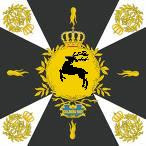The Aschenbach army, fresh from it’s victory at Flussburg, attacked in classic ‘Frederickian’ style – it partially orbited the Luftberg position, screening it’s movements behind a large forest, before emerging from the trees to roll up the Luftberg line.


Faced with the Luftberg right wing cavalry under General La Spezia (which included the dreaded Schrodinger Cuirassiers KR2), the Aschenbach infantry couldn’t risk being charged down in column and had to deploy early into line, which cut the speed of their advance and permitted the Luftberg army time to rush northwards to form a new line.


Unable to press along a narrow front on the flank, the new Luftberg and Aschenbach lines rushed to deploy against each other in the open plain before the hills, which meant the battle resembled a ‘meeting engagement’ where each side’s plan had failed – Luftberg had lost it’s solid defensive position, while the Aschenbach attack had sprawled out into a longer line than intended.

The forces close on each other
General von Kleintrink was certainly not inactive, rushing forward to try and slow the Luftberg response to the attack. He was forced to confront the Luftberg cavalry on their left wing first however, and each side launched several charges and counter-charges. Von Kleintrink was seemingly a man possessed, throwing safety to the wind over and over again to inspire his troopers on. Finally it paid off, and he led Von Schnitzel’s Cuirassiers (C1) as they repelled several attacks from the enemy horse before launching a furious charge that swept away both the Cuirassiers and Dragoons of Haas & Krauss’ regiments. While he was reforming his command however, the Luftberg heir Conrad von Hentsch had turned his adjacent infantry regiment of Negrelli (IR4) to face the horsemen, and they poured a destructive fire into the flank of the recently triumphant Cuirassiers.
Kleintrink's first approach to combat
After the charge, with the blown horsemen being hit in the flank by Negrelli (visible in the background)
The main infantry lines now closed on each other, and although the Luftberg line was stretched thin with no reserves, the delayed progress of the Aschenbach flanks allowed them to adopt a slightly concave line and concentrate fire on the approaching bluecoats. The Major Ungaurn proved his skills as the advancing IR6 von Rechnung found itself being battered by cannon-fire of unerring accuracy. Perhaps they’d simply given too much in the preceding battle at Flussburg, but their attack lacked the fire of before as Ungaurn’s guns and O’Brien’s (IR3) spirited charge battered them down to a stand-off.
The main infantry battle (Major Ungaurn in the front foreground)
More critical was the advance of the Hirschburger grenadiers on Von Rechnung’s flank. The regiment bore down on the opposing Beerstein regiment, and the Elector von Luftberg had a moment’s panic about how they would resist this assault. In the event however, the Hirschburger advance was undermined by the Aschenbach fusiliers on their flank – unexpectedly charged by Radetzky’s IR1and unwisely allowing the Regent von Krumper to interfere with his advice [ie, they used his command dice to reroll a so-so combat dice, only to get a disastrous reroll], they were disastrously scattered. The Hirschburgers were battered by artillery on their slow approach, had concentrated fire from the flanks as Radetzky angled inwards, plus the Beerstein infantry blazed away to their front. Although the doughty grenadiers still pushed to close combat with the Beersteiners, they were too weakened to break through and finally collapsed in the face of canister fire from the Luftberg guns.
The Beersteiners have their moment of crisis
The Aschenbach advance was winding down and collapsing, with no prospect of the desired breakthrough and many regiments reduced to battered remnants. As the Grenadiers were lost, Von Rechnung’s IR6 found itself in danger of a double envelopment and fell back.
The last furious effort came from (who else?) General Von Kleintrink, who threw his reserve of hussars at the infantry of Negrelli for some revenge on the regiment that had so mauled his horsemen. Leading Negrelli’s men in the fight was Conrad von Hentsch himself, who was in the thick of the fighting. The hussars charged and were scattered, with von Kleintrink once more proving himself indestructible. Such good fortune did not accompany von Hentsch however, who became a casualty as a bullet from some Hussar’s carbine found him in the middle of the fray.
"Victory, thy caress is bittersweet... I mean, I think I'm dying - get a doctor!"







5 comments:
Very nice battle report as usual! Enjoyed the pictured and hearing of the success of the Beerstein Brigade. Reich Duke Wilhelm was concerned they might not arrive in time for the battle. Few things compare to see blue coats on the run! Congratulations on a fine victory...Wilhelm
Enjoyable battle report and pictures!
As a result of the Battle of Althirschburg do you have any general who would quality for induction into the Order of the Golden Crown "Awarded to Generals for victory, gallantry, and heroic daring do on the field of battle".
Best regards...Wilhelm
Hi Bill. Hmm, I suppose the only real candidate would be the Elector Ulrich von Luftberg - commander of the army, victor at Vogelhof & Althirschburg. Thanks very much! A proper ceremony and acknowledgement will take place shortly at the campaign conclusion,
Ta,
C
I am enjoying these accounts of your campaign. I really like the idea of pre-battle maneuver on maps. It really seems to set up a far more interesting battle scenario as opposed to just lining up the troops and charging forward.
Post a Comment